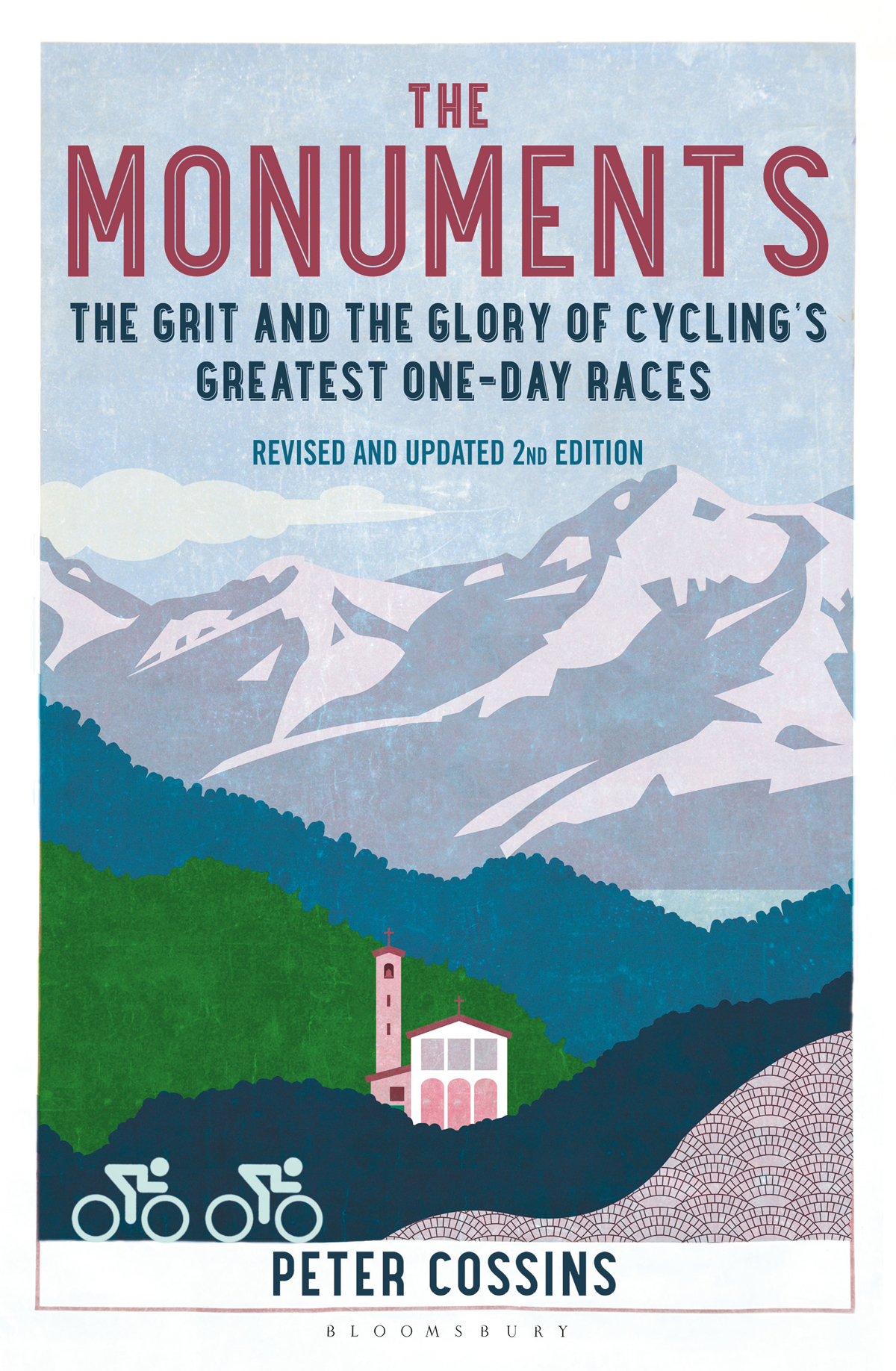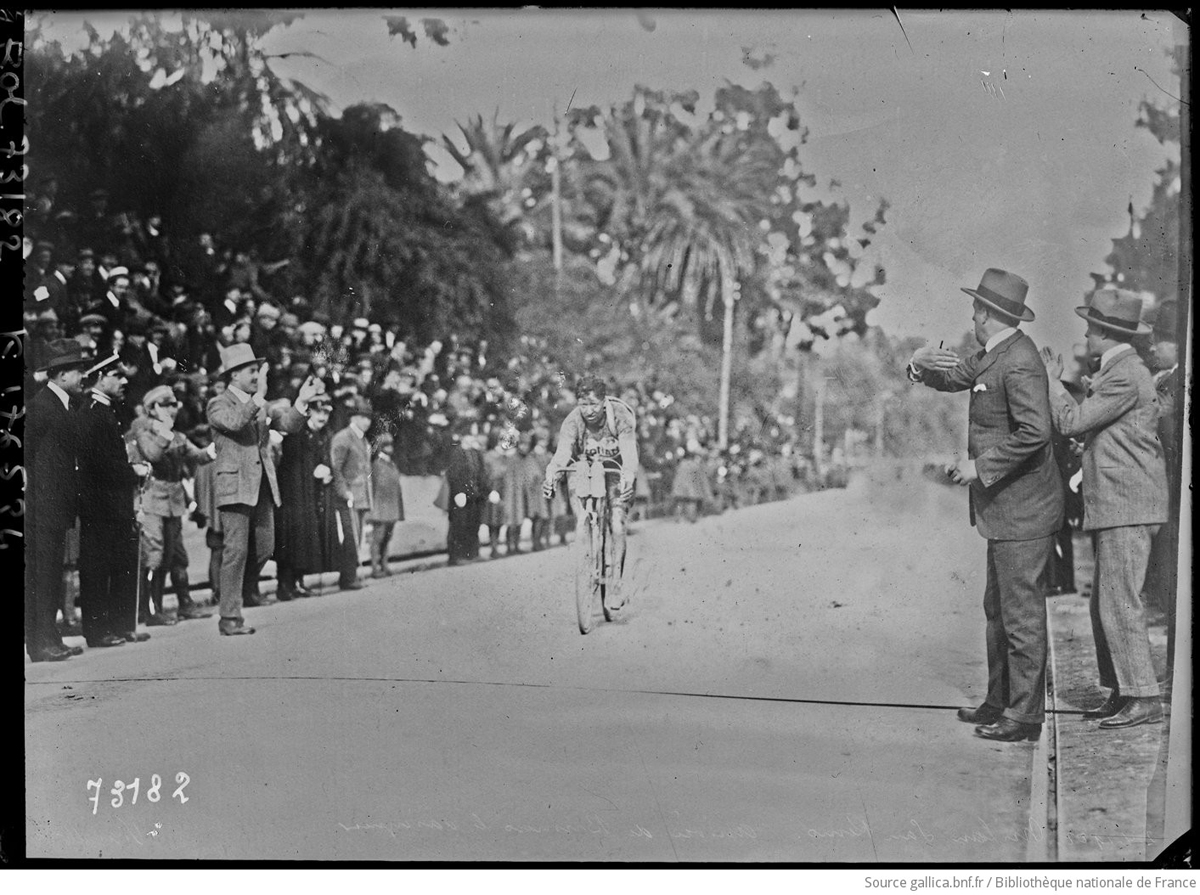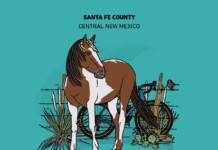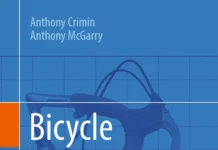By David Ward — If I were to nominate one day as the greatest day of professional bike racing in terms of determination, wonder and pure grit, I would propose the 1910 edition of Milan-Sanremo, La Classicissima, won by Eugène Christophe, he of Tour de France fame who in 1913 had to run down the slopes of the Tourmalet carrying his bike for two hours before arriving at a smithy’s forge where he welded his broken fork before continuing on. In The Monuments: The Grit and the Glory of Cycling’s Greatest One-Day Races, author Peter Cossins quotes from Christophe’s account of that day which appeared in French magazine, Miroir des Sports. Only 7 of the 71 riders at the start line finished, with 3 being disqualified, as Cossins describes, “for what in the circumstances might be argued was legitimate bending of the rules.”
 “’Not far from the summit [of the Passo del Turchino] I had to get off my bike because I started feeling bad. My fingers were rigid, my feet numb, my legs stiff and I was shaking continuously. I began walking and running to get my circulation back,’ said the Frenchman, who recalled the wind moaning frighteningly. As he continued on, he described seeing some riders swigging brandy straight from the bottle, others swallowing eggs and a few chewing on grass, all of which were thought to stave off fatigue. Told he was six minutes down on leader Cyrille Van Hauwaert, Christophe trudged on to the tunnel at the summit of the Turchino, where he got a brief respite from the elements …
“’Not far from the summit [of the Passo del Turchino] I had to get off my bike because I started feeling bad. My fingers were rigid, my feet numb, my legs stiff and I was shaking continuously. I began walking and running to get my circulation back,’ said the Frenchman, who recalled the wind moaning frighteningly. As he continued on, he described seeing some riders swigging brandy straight from the bottle, others swallowing eggs and a few chewing on grass, all of which were thought to stave off fatigue. Told he was six minutes down on leader Cyrille Van Hauwaert, Christophe trudged on to the tunnel at the summit of the Turchino, where he got a brief respite from the elements …
‘I just got on with going down through the snow that lay on the road on that side of the mountain. The view was totally different now. The snow made the countryside beautiful. The sky was clear. But now it was my turn to have trouble. It was hard to keep going. In places there were 20cm of snow. Each time I was obliged to get off and push. Then I had to stop with stomach cramps. I collapsed on to a rock at the side of the road. I was freezing.’
Christophe noticed a house a few hundred metres away. He later admitted he was torn between carrying on (victory would see his wage doubled) or making for the house. In the end, a man emerged from nowhere and made the decision for him.
‘He led me to what was a tiny inn. The landlord undressed me and wrapped me in a blanket. I murmured ‘acqua calda’ and pointed at the bottles of rum. I did some physical exercises and started to get some feeling back in my body. I wanted to go on, but the patron wouldn’t hear of it and pointed to the snow still falling outside. Not long after, first Van Hauwaert and then Ernest Paul came in. They were so frozen they put their hands in the flames. Ernest Paul had lost a shoe without noticing.’
Looking out of the window, Christophe saw ‘at least four piles of mud’ weaving past. Knowing others were still racing, he decided to press on … ‘I had to trick the innkeeper by saying I was going to meet someone who would get me to Sanremo by train,’ said the Frenchman, who took up the innkeeper’s offer of dry clothes and a new pair of trousers, which he soon had cut down to shorts to relieve himself of the mud weighing them down. Back on the road, he steadily caught and passed the four Italians ahead of him, including defending champion Ganna.
‘At the control point at Savona everyone was astonished to see me alone … I was sure of my victory and with only 100km to go I felt a new strength. The idea of crossing the line brought back all my energy,’ Christophe recalled.
He finally completed the course in 12 hours and 24 minutes. Ganna came in second but was later disqualified for putting his bike in a car and walking up the Turchino. A second Italian was disqualified for taking the train between Pavia and Novi Ligure, while a third, Sante Goi, finished seventh but after the Sanremo control point had closed.
This is only one example of the spell-binding writing found in Cossins’s book. I can honestly say that of all the books I have read, and not just cycling books, this is one of the most fascinating. Being an avid cyclist and having followed professional cycling for nearly forty years, I was especially intrigued by the history, events and people featured in the pages of this book. Names of people and places that I have heard or read about began to fit together in a more organized fashion.

Cossins takes on the task of telling the tale of five monumental classics: Liège-Bastogne-Liège (La Doyenne, 1892), Paris-Roubaix (La Pascale/Hell of the North, 1896), il Giro di Lombardia (The Race of the Falling Leaves, 1905), Milan-Sanremo (La Classicissima, 1907), and The Tour of Flanders (Vlaanderens Mooiste/Ronde van Vlaanderen, 1913). The book is divided into five sections, tackling each monument in order of the year it was established. In each section Cossins relates the founding and ensuing development and history of each classic. He interweaves the names and efforts of the founders, directors, team managers and, most importantly, the riders who have made these races great, who made them classics and continue to maintain their classic status. He also weaves in a lot of related history and incidents.
Liège-Bastogne-Liège is the oldest of the Monuments. But it had a rough time getting established, disappearing from 1895 – 1907, again in 1910, and then for the WWI years of 1914-1918. After WWI, it became well established and a recognized classic, only missing four years during WWII. As Cossins relates, most of the famous pro cyclists have sought to win this classic. A reading of the list of winners is a literal “who’s who” of renowned cyclists, including Jacques Anquetil, Eddy Merckx (a record five times), Moreno Argentin (four times), Bernard Hinault (his 1980 win in the wind and snow having been voted by the readers of French magazine Vélo as Hinault’s greatest win), Sean Kelly and Alejandro Valverde (three time winner) and a host of others.
The last half century of Paris-Roubaix is one of trying to preserve the cobbled roads on which the race is run. The organizers were constantly looking for new sections of “pavé” as roads continued to be resurfaced with tarmac. One such discovery is now almost synonymous with Paris-Roubaix, the Tranchée d’Arenberg (Arenberg Trench). Jean Stablinski, at 19, worked as a coal miner in this region prior to his career as a pro cyclist. Later, he introduced this area to the organizers of Paris-Roubaix who subsequently incorporated the Tranchée into the race in 1968. Stablinski was in his final season that year and was among those who raced over the Tranchée for the first time. Said Stablinski after the race, “Not many people know it, but an underground roadway runs directly below the Tranchée. I am the only man to have walked under and raced over the cobbles of Arenberg.
Cossins relates a few other fascinating Paris-Roubaix tidbits. Initially, racers were “paced” by other riders and subsequently, for a few years, by motor vehicles and motorcycles. Also, Paris-Roubaix took on the nickname, La Pascale, because it was often held on Easter. And finally, of interest to us Americans, Major Taylor raced in the Roubaix velodrome where Paris-Roubaix finished.
One tragic yet touching story arising from Paris-Roubaix is that of René Pottier. Cossins relates how Georges Passerieu, upon winning the 1907 edition, said, “I would like to point out that I am wearing the jersey of the unfortunate René Pottier. He was my mentor and friend.” The winner of the 1906 Tour de France, Pottier had hanged himself “after discovering that his wife was having an affair while he was away winning the Tour.”
The Tour of Lombardy is responsible for the birth of cycling’s most sacred location, the Madonna del Ghisallo chapel in Magreglio, Italy. As Cossins writes, “In October 1948, Pope Pius XII lit ‘the permanent flame of the Ghisallo’. The lamp containing the flame was transported by car to Milan … From there, a relay of cyclists including [Fausto] Coppi and Gino Bartali carried the flame up to the small chapel … at the top of the Ghisallo Pass”, the Tour of Lombardy’s most famous point.
Lombardy is also remembered for the antics of Italian fans in support of their home riders. In 1906, Italian Giovanni Gerbi was accused of orchestrating “damage to the route that slowed his rivals and caused them to crash, use of pacers and encouraging his supporters to block a level crossing and spread nails along the route.” And that, apparently, was just the start of such antics.
The Tour of Lombardy is the only classic in which a woman competed. Alfonsina Strada participated in two wartime editions of Lombardy, finishing both races and, in 1918, was only 23 minutes down on the winner, Gaetano Belloni. She also raced in the 1923 Giro d’Italia. Also of interest is that the man waving the red flag to start the first running of the Tour of Lombardy was Romolo Buni, a former track star who became famous after engaging in three races against William “Buffalo Bill” Cody, with Cody on a horse and Buni on his bike.
The Tour of Flanders, Ronde Van Vlaanderen, originated as part of an effort to publish a Flemish newspaper and raise the social stature of the Flemish people. At the time, the Flemish language was considered a baser language, with French being the language of the Belgian elite and those seeking a higher status. Cossins quotes Karel Van Wijnendaele, one of the originators of the Ronde, as saying, “We wanted to publish a paper to speak to our own Flemish people in their own language and give them confidence as Flandrians.”
So, Van Wijnendaele, Leon Van den Haute and Augustin De Maeght, inspired by Paris-Roubaix, came up with the idea of establishing a Tour of Flanders, recognizing that the race and the newspaper (Sportwereld) would help promote each other. Though initially boycotted by French teams as being beneath them, the bicycle manufacturers who sponsored the professional teams recognized the need to expand their markets into Belgium to generate more revenue with which to sustain their teams. So, they reversed course and started sending their top riders to the Ronde. Cossins notes that, initially only bicycle companies were permitted to sponsor professional cycling teams and it was not until 1954 that outside sponsors were permitted.
Monuments delves into other aspects of cycling relating to these classics. Cossins doesn’t shy away from the inclusion of the impact of doping, relating history that makes it clear that artificial performance enhancement was not uncommon in the early eras of bicycle racing. He also looks at its presence in modern cycling, particularly in the 1990s and 2000s. Cossins also looks at the impact of politics, and World Wars I and II, on professional racing, from those who used cycling to further political ends, to those who cooperated with the Nazis and/or puppet governments, as well as those who secretly worked against the Nazi occupation.
If I have a complaint about the book, it stems from the packed nature of Cossins’s narrative. Mostly, I found I would lose track of which year or which edition of a race he was referring to and kept having to refer back to orient myself or make a physical note about which year he was discussing. But that was a minor irritation in contrast to the rich nature of this book.
In his Endpiece, Cossins quotes Thor Hushovd: “These races are brutally hard, they are dirty, they are very long. Everyone knows the rider who wins these races is a really tough guy, a true hard man. Then you think about the history of these races, you look at the great names that have won them in the past, and you realise what it would mean to win one of them, that your name would go down alongside all of cycling’s legends. I love riding them.”
Cossins goes on to say, “The Tour [de France] may offer fame and wealth, but the Monuments provide their own special glory and an indelible connection with the great champions of the past, with those riders whose deeds made landmarks like the Poggio, Kwaremont, Arenberg, La Redoute and Ghisallo as renowned as any of the sport’s legendary places. No wonder Hushovd and every racer alongside him in the pro peloton wants to win one.”
Amen to that.
The Monuments 2nd edition: The Grit and the Glory of Cycling’s Greatest One-Day Races
Author: Peter Cossins
Imprint: Bloomsbury Sport
Price: $20.00
ISBN-13: 9781399407861








